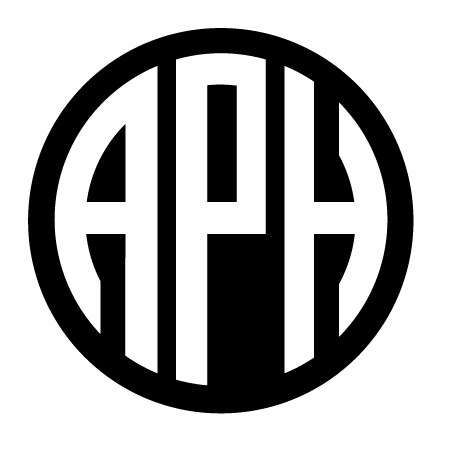APH News: January 2017
Your monthly link to the latest information on the products, services, and training opportunities from the American Printing House for the Blind.
Exciting New APH Products Announced!
Read on to learn about these new products – now available!
- NEW: Little Breath of Wind — UEB
- NEW! APH Braille Badges for iOS devices
- APH Winter Wonderland Sale
- APH Braille Book Corner
January is Braille Literacy Month
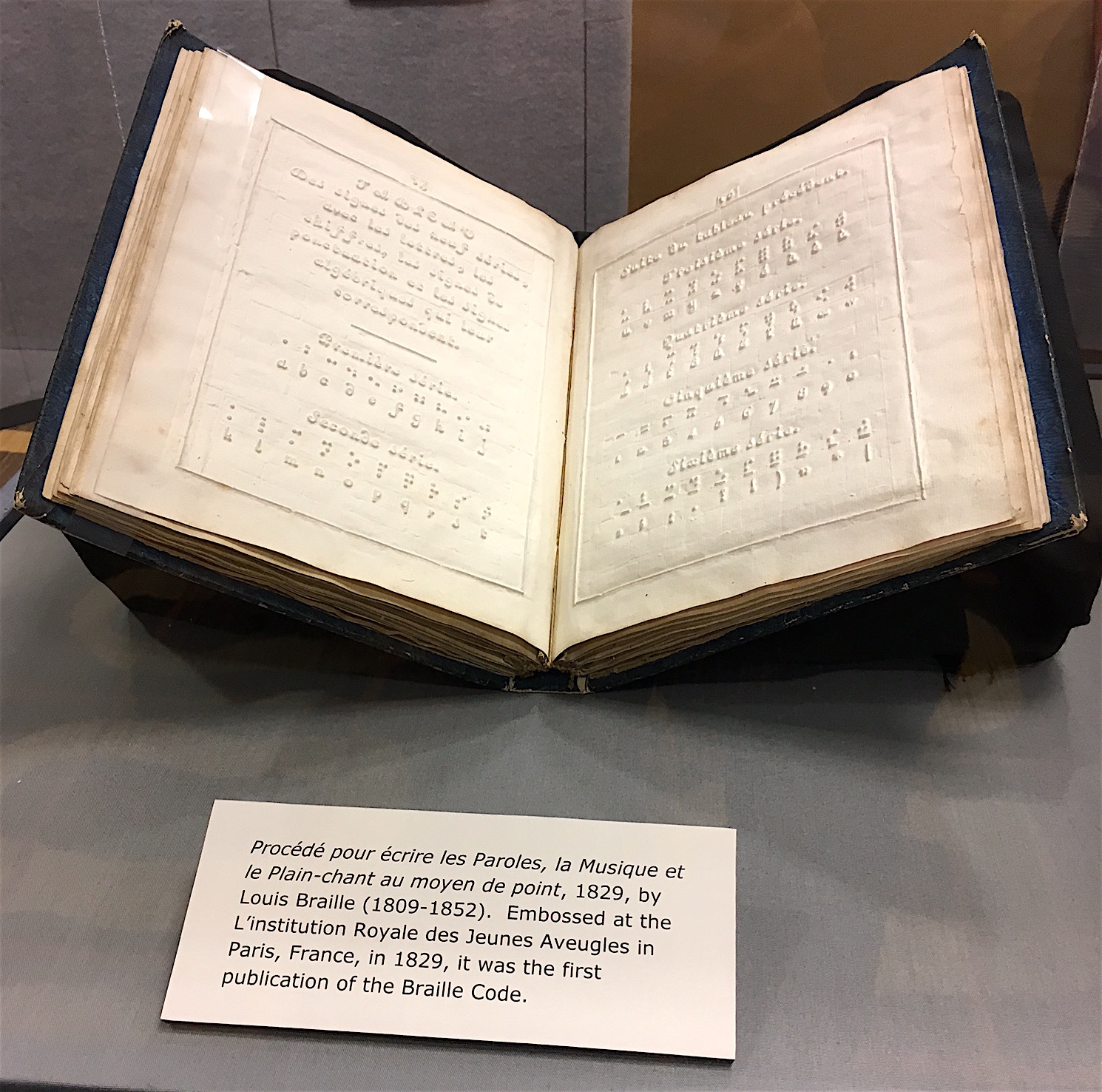
APH’s copy of Procédé pour écrire les paroles, la musique et le plain-chant au moyen de point, 1829, by Louis Braille (1809-1852).
Dear Readers:
January marks Braille Literacy Month, an opportunity to take a step back and contemplate the importance of braille in the lives of children and adults who are visually impaired or blind. Literacy has taken on increased importance in our world as we’ve moved through history, and it has never been so critical to success and fulfillment as it is today. The ability to read and write, whether using the senses of vision, hearing, touch, or a combination of senses, is considered a critical skill for employment and leading a well-rounded life.
Literacy through touch has not always been a given for those who are blind, and methods of reading tactually have evolved. Thanks to APH Museum Director Micheal Hudson, we are able to provide you with a detailed chronology of the evolution of braille and the literacy it has brought to the hands of thousands of individuals.
Landmarks in Braille Literacy
1786: Valentine Haüy pioneers literacy for people who are blind when he invents the raised letter book at the Institut Royale des Jeunes Aveugles in Paris, France.
1829-1837: Louis Braille introduces an elegant and easy-to-learn tactile code based on dots, providing a simple way to read and write. Its adoption around the world will take many decades.
1854: The Braille System is formally adopted in France, two years after the death of Louis Braille from tuberculosis.
1860: The system is published for the first time in America by the Missouri School for the Blind.
1871: The American Association of Instructors of the Blind(AAIB) adopts an American adaptation of braille—New York Point—and it is soon widely used in American residential schools.
1875: The American Printing House for the Blind(APH) publishes its first New York Point book.
1878: Joel Smith, a teacher at the Perkins Institution, introduces a second adaptation of braille that he calls Modified American Braille. It is used by only a few U.S. schools initially, but they are influential—Perkins, the Overbrook School, etc. The period of competing systems will become known as the “War of the Dots.”
1892: Frank Hall, Superintendent of the Illinois School for the Blind, invents the Hall Braille Writer, the first successful mechanical braille typewriter. In 1894, Hall invents a stereotyping machines allowing the inexpensive and rapid production of embossing plates. The plates allow a dramatic expansion in braille production over the next thirty years.
1893: APH embosses its first textbooks in Modified American Braille.
1905: The Uniform Type Committee is formed by the AAIB and the American Association of Workers for the Blind(AAWB) to adopt a single uniform code for all English speaking readers. The committee decides that British Braille—basically the original French alphabet code with a complicated set of contractions—was superior to both New York Point and Modified American Braille. Initially, the committee adapts a new code—Standard Dot—that combines the strengths of all three, but there is no enthusiasm for Standard Dot outside the U.S.
1918: After years of unsuccessful negotiations with the British, the Uniform Type Committee adopts Braille Grade One and a Half, basically British braille but with a simplified set of contractions. British readers can easily read the American code, but American readers cannot read the British.
1932: At the London Type Conference, delegates from the English speaking world approve a uniform braille system, Standard English Braille. It is mostly the British braille code from 1905, but with a concession to the Americans, contractions do not break over syllables.
1941-53: Thousands of infants have their sight damaged by the oxygen in their hospital incubators. The educational community is unprepared for the sudden spike in BVI students. Many overflow into the public schools, just as public opinion is shifting against segregated schools for children with visual impairments. In the public schools, Braille education is generally poor, and students with failing but residual vision are encouraged to use audio players and video magnifiers. Braille literacy in this generation drops dramatically.
1950: The Joint Uniform Braille Committee is formed by the AAIB and the AAWB to approve some proposed changes in Standard English Braille. In 1952, the committee recommends the adoption of the Nemeth Braille Code, an advanced code for mathematics.
1959: English Braille, American Edition is adopted by the AAIB and AAWB. The Joint Committee becomes the AAIB-AAWB Braille Authority.
1960s: Working with International Business Machines, APH adapts computers to translate print to Braille, dramatically increasing the speed of translation, and later, overall production.
1976: Oleg and Andie Tretiakoff, working in France, introduce the first commercially available paperless braille machine, the Digicassette. More advanced machines soon follow.
1976: The Braille Authority restructures, inviting other blindness organization to participate, into the Braille Authority of North America(BANA).
1990s: Blindness organizations begin to react to decreasing braille literacy. BANA determines that one cause is the complexity of the code and begins work to revise it. Organizations like APH develop tools to help parents and teachers assess at an early age when braille is the right choice. Consumer groups like the National Federation of the Blind and the American Council of the Blind, unable to unite on other issues, are unified in their promotion of braille literacy. University programs responsible for training the next generation of teachers reemphasize braille.
2004: The Individuals with Disabilities Education Improvement Act is passed, requiring the creation of the National Instructional Materials Access Center(NIMAC), where parents, students, and teachers can find source files to produce accessible, student-ready specialized formats, such as Braille and audio, for students in K-12 with qualifying disabilities.
2012: BANA passes a motion to formally adopt Unified English Braille, a revised code which seeks to bring braille into the 21st century.
2017: APH introduces the Orbit Reader 20™, the first refreshable braille display available commercially for under $500. The Orbit 20 is the end product of the Transforming Braille Group, an international body formed in 2011 and spearheaded by the Royal National Institute for the Blind in England.
Coming Soon!
Orbit Reader 20
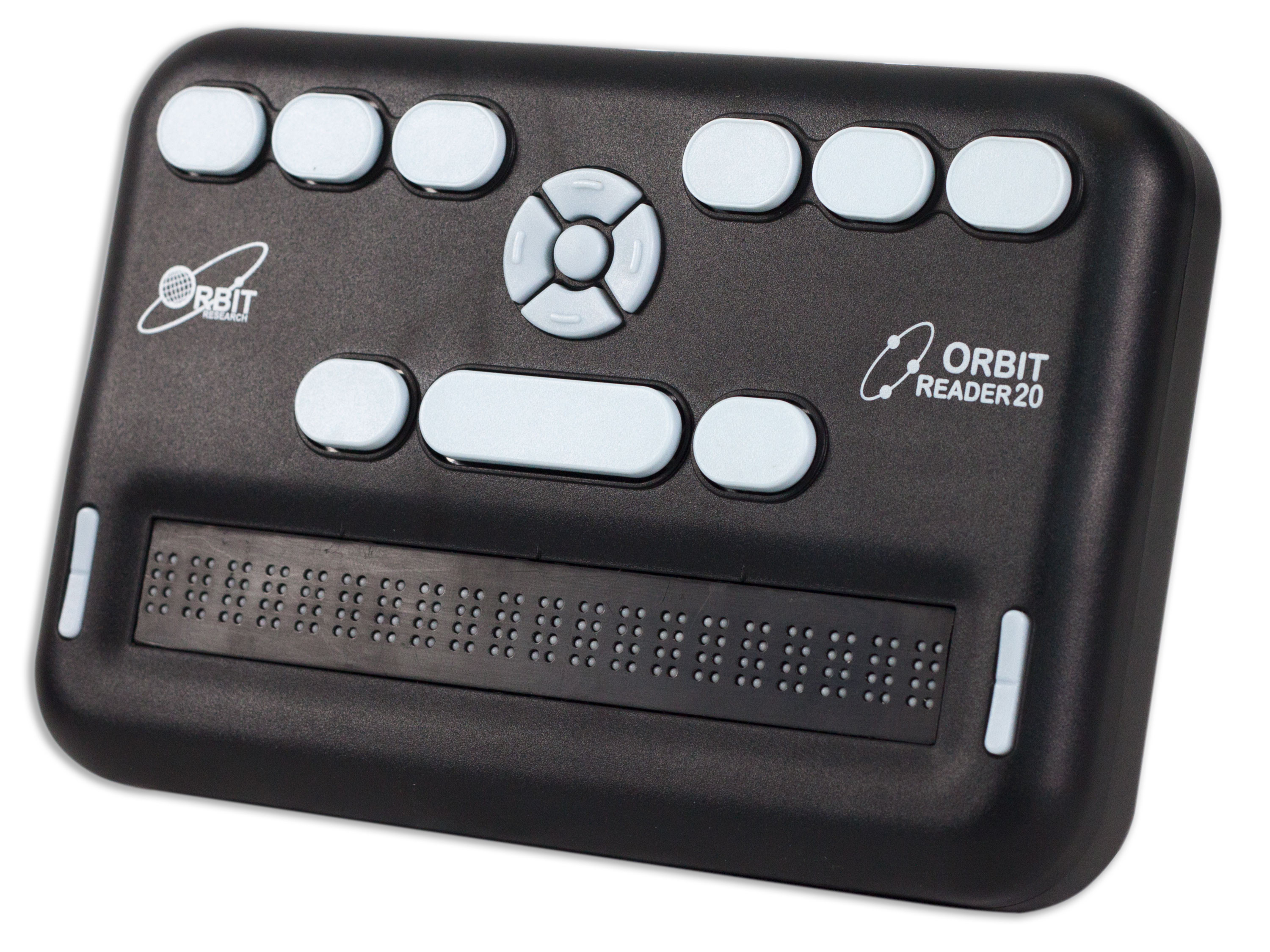
Orbit Reader 20™ is the perfect braille literacy tool. Developed from the beginning directly through the input and design of the end user, it combines price consciousness with simplicity and utility.
Recognizing that electronic documents and more efficient distribution could extend literacy to millions of blind people around the world, Transforming Braille Group LLC (TBG) vowed to disrupt the market and increase literacy by developing a refreshable braille display at a fraction of the cost of the current solutions.
TBG consists of the following member organizations that funded the development of this amazing device:
- Association Valentin HauY (AVH)
- Blind Foundation (formerly RNZFB)
- The Canadian National Institute for the Blind (CNIB)
- National Federation of the Blind (NFB)
- The American Printing House for the Blind Inc (APH)
- The Norwegian Association of the Blind and Partially Sighted (NABP)
- Perkins School for the Blind (Perkins)
- Royal National Institute of Blind People (RNIB)
- Sightsavers
- Vision Australia (VA)
The group tackled a monumental problem; the cost of refreshable braille technology did not follow Moore’s law which generally states that the cost halves and the capabilities of electronics double every 18 months. To produce a braille literacy tool using refreshable braille technology, they needed something radically different.
With nearly 1.5 million in funding and extensive testing and feedback from member organizations, TBG contracted with Orbit Research to design and manufacture a 20 cell refreshable braille display and reader, and the result is better than anyone expected.
About the Orbit Reader 20
The Orbit Reader works by itself to show braille from files on an SD card, and it connects to computers and mobile devices through USB or Bluetooth to read anything with any accessible app on that device.
Using Orbit Reader stand-alone (not connected to another device) shows the contents of files from the SD card reader located on the rear edge. Libraries can send content on SD cards to patrons, and individuals can put content onto the card by using software on their computer.
There are panning buttons to let you move sequentially through the content of a title, and navigation and searching commands permit quick access to specific parts. There is also a file manager to make finding and organizing titles easy.
Inexpensive smartphones in use around the world and more attention to accessibility from companies like Apple, Google, and Amazon makes using apps like Kindle, iBooks, or Play Books with braille quite efficient and feasible for an increasing population even in developing countries. Other apps, like Voice Dream Reader, extend the flexibility by increasing the library to more content.
The inclusion of a high quality braille keyboard makes it possible to interact with those apps, too, so you may use tools like Microsoft Word or send texts by typing in the contracted or uncontracted braille code of your desire and have it appear to the other user as regular text. After over a year of iteration, refinement, and further testing, the end users selected a keyboard that is quiet, smooth, and accurate. Having started the project with cheap buttons, users quickly expressed the desire for quality input methods, and TBG responded with a double scissors action key technology among the best in the industry.
Along with the keyboard for input, Orbit Reader includes a simple editor, so you can take notes or write documents and save them on the SD card.
The objective of this project is not to compete with high-end braille note takers. Instead, TBG hopes to put this device into the hands of millions of blind people around the world who may not be able to afford the premium models or who don’t know if the feature rich devices are right for younger students or those that do not desire the added complexity.
Orbit Reader is simple. It performs few functions, but it does them well. It acts like any other refreshable braille display when connected to another device, and it offers reading, file management, and editing in the stand alone usage model.
It does not contain Wi-Fi, browsers, or word processors. To use those kinds of tools, you run them on your computer, tablet, or phone and let the Orbit Reader serve as the display and/or input method.
Orbit Reader uses a new braille technology. It is different from the standard in how it looks and feels. Size and spacing are the same, but the firmness, prominence, and refreshing techniques are all different. Many find them the best they have ever used.
The first thing you notice is the sound. It makes a distinct but pleasant sound as the cells refresh. In addition, the refresh is not simultaneous. Instead, you hear each cell update from left to right. The refresh rate, in fact, was probably the most controversial aspect of the whole project. It takes a little longer to refresh the entire line, but testing indicates that most users considered the refresh rate adequate.
The quality of the braille dots is the next pleasant surprise. Many equate it to signage quality braille like you might see on a hotel room or elevator. It is distinct, and the cells do not retract as you push on them. It is also crisp like you might see with thermoformed braille.
Orbit Reader was designed to work in challenging environments and to be serviceable. To those ends, it contains a unique membrane that separates the top portion of the pin comprising each braille dot in a cell from the inner mechanism. This membrane keeps dust and moisture from getting into the moving parts.
The battery charge lasts for several days under normal use, and the user can replace the battery herself when it begins to show signs of wear.
The Transforming Braille Group received a total of 103 evaluations from four countries.
Production units are leaving the factory during the second week of January. They will be tested and packaged for delivery before Spring. APH has already written documentation and started creating videos.
For more information, see http://tech.aph.org/or20
NEW: Little Breath of Wind — UEB
6-77950-00 — $149.00
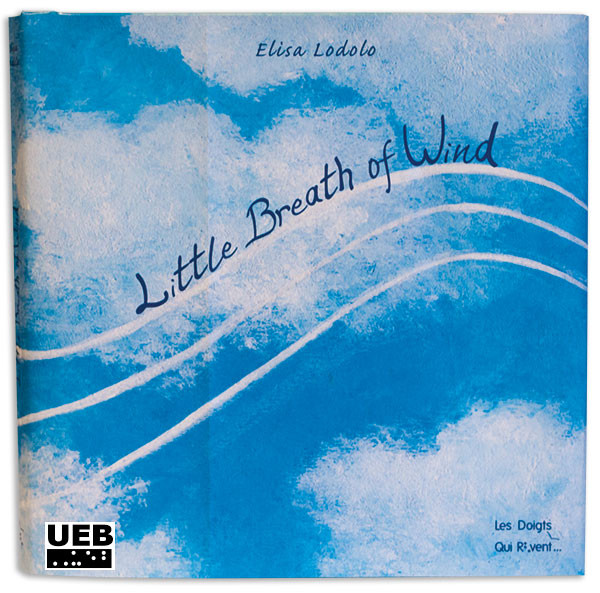
First released in 2013, this book is back in Unified English Braille (UEB)!
This young children’s storybook features charming text and tactile illustrations that invite exploration, using a variety of richly textured, collaged fabrics and raised lines of thick, soft yarn. It tells the story of a “breath of wind” that begins its journey one morning, blowing across a meadow of soft grass, tickling the leaves of a tree, until it arrives “at my ear… to tell a story, a voyage of adventure.”
The young child moves his or her fingers along the lines of yarn following Little Breath of Wind across each page. The book’s text is provided in large print and contracted UEB braille. The clear, silkscreened braille is high quality and extremely durable. Originally produced in Italian and French, the English version is produced for APH by Les Doigts Qui Rêvent (LDQR) workshop in Dijon, France.
Tactile Illustrations Support Learning
Visual illustrations in children’s books play a number of important roles, helping him or her to:
- Actively explore and relate text and illustrations to gain a fuller appreciation of a book’s meaning
- Talk about the illustrations as the book is read and shared, promoting oral language skills underlying literacy
- Gain basic skills needed to examine and interpret tactile displays
- Use tactile illustrations as a guide to pretend read or to fill in words he or she is not yet able to read
Tactile illustrated books offer a bridge, helping a young child take a more active role in book reading, as a listener and as a beginning reader.
Recommended Ages: 5 years and up.
WARNING: Choking Hazard–Small Parts. Not intended for children ages 5 and under without adult supervision.
NEW! APH Braille Badges for iOS devices
D-30024-AP — FREE
Start out the year in style by texting your friends the latest in iMessage® stickers with APH’s free Braille Badges, now available on the App Store®! These fun, accessible stickers are great for sharing with friends and family alike. Send a simulated braille message, the Braille Badge Superhero, a festive pic of Poncho the dog guide, or many more fun stickers. There are 19 stickers in all, and more will be added periodically! Download them free to your iOS® devices running iOS 10 or later.
Some of the stickers include:
- Simulated braille stickers
- Holiday-themed stickers
- Animated mustache man with sunglasses
- Animated walking cane
- Braille superhero
- Poncho the dog guide
- Many more!
How to Use
After downloading, within the Messages app, look for these stickers under the “Message Apps” button (the button containing the capital “A” shape) in your text message screen. You may need to open the “apps drawer” using the four-dot icon at the lower left of the screen to see Braille Badges.
Available on the App Store: http://itunes.apple.com/us/app/braille-badges/id1173603989?ls=1&mt=8
IOS is a trademark or registered trademark of Cisco in the U.S. and other countries and is used under license. iMessage is a trademark of Apple Inc., registered in the U.S. and other countries. App Store is a service mark of Apple Inc.
APH’s Websites: We Want Your Feedback on Accessibility!
When accessing the web, are you a synthetic speech user, screen magnification user, or user of other accessible technologies? APH would like your feedback on the accessibility of our websites! If you have thoughts about the accessibility of the following: archive.aph.org, shop.aph.org, or showcase.aph.org, please email your comments to communications@aph.org. We appreciate your time!
APH Winter Wonderland Sale

Load up a world of savings on selected APH products with APH’s Winter Wonderland Sale 2017, January 1—March 31. As always, first come, first served.
STEM Corner—A New Regular Feature!

Science Teachers and TVIs!
APH is Cooking With Science!

APH sells an excellent talking thermometer that measures temperature in Fahrenheit and Celsius degrees, accurate to the tenth of a degree! It is not available with quota funds, but it costs only $39.00. You can find this item listed in the APH catalog as a Talking Cooking Thermometer, catalog number 1-03992-00, or buy direct from ThermoWorks www.thermoworks.com (RT8400) for the same price.
And, here is a link to an awesome and adaptable demonstration of the 4.5 billion year history of the Earth:
Denna Lambert: Out of this World Keynote Speaker!
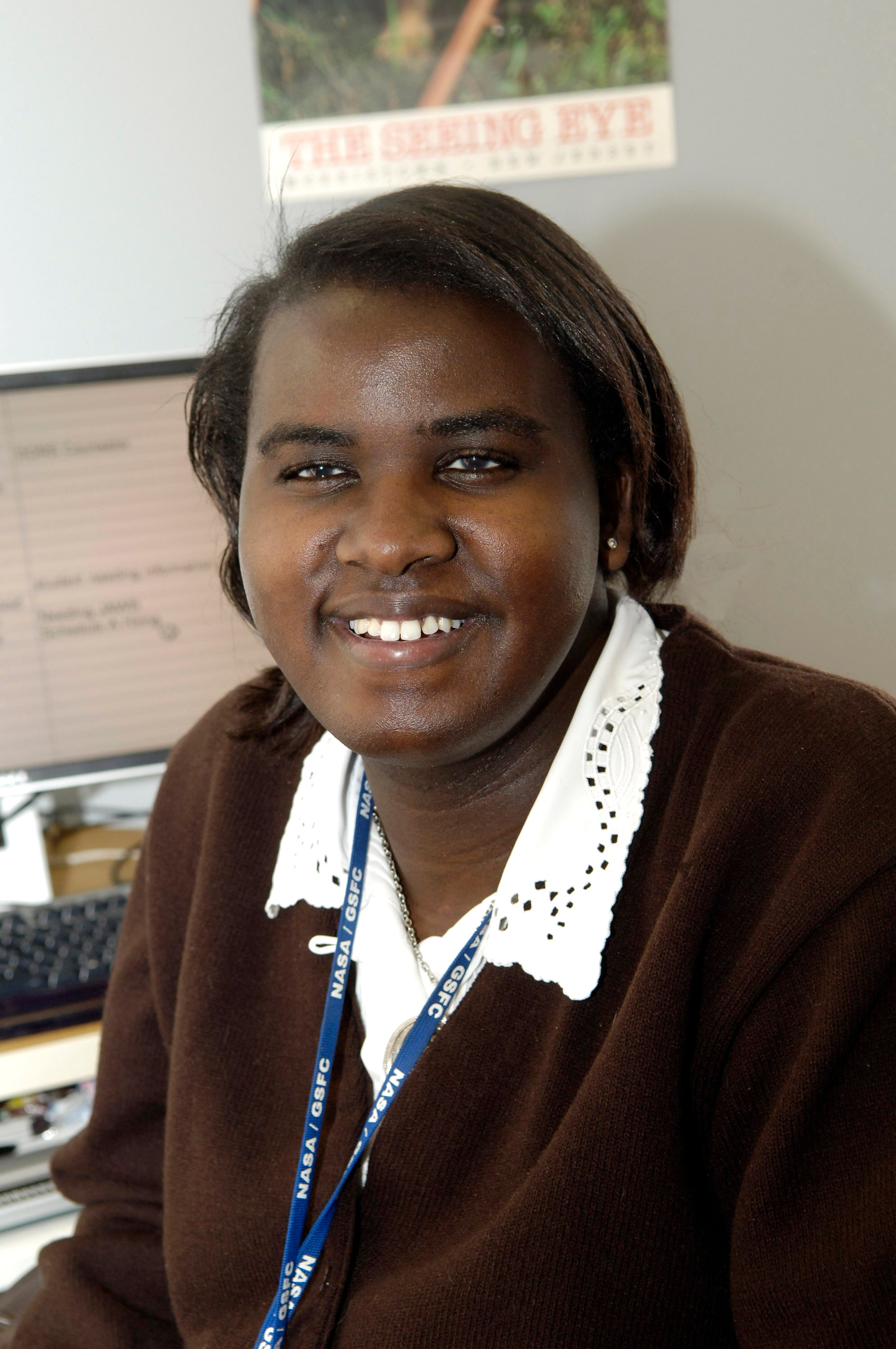
Start off the new year with some inspiration! The opening session of Annual Meeting 2016 was a story of success as our keynote speaker, Denna Lambert, shared her personal journey of boldness, strength, and the power of working together to reach goals. Lambert, a lifelong user of APH products, holds degrees from the University of Arkansas and the George Washington University, where she earned a Masters of Public Administration. She is a Program Manager with NASA’s Goddard Space Flight Center, Greenbelt, MD, where she coordinates the Center’s efforts in developing and launching the Information and Collaboration Center (GIC2).
APH is a Golden Apple Developer of the Year Winner!

Applevis.com is an online community of enthusiastic blind Apple product users. This group teaches and explores Apple’s accessibility achievements and encourages other developers to use the built-in resources to make their products equally accessible.
For the last five years, they help express their recognition and appreciation by voting on the best apps and developers and award the Golden Apple.
For 2016, APH wins a Golden Apple as one of two developers of the year for its work on Nearby Explorer for iOS, a navigation app that uses the combination of compass and GPS on your phone, extensive maps, and the phone’s position to help provide a detailed description of immediate and remote locations.
Project Leader Rob Meredith heads up a team continuing to develop and extending this app to cover the next frontier in navigation, the indoor spaces. Also working diligently are Mike McDonald, Keith Creasy, Mark Klarer, Ken Perry, and Jeremiah Rose.
Candidates for the Golden Apple award for Developer of the Year from AppleVis must:
- Have an exemplary commitment to making their apps fully accessible to blind and low vision users;
- Be receptive and responsive to the needs of blind and low vision users in a timely manner; and
- Have delivered significant new features or updates to their app(s) during 2016, particularly updates which directly benefit blind and low vision users.
Rob and team fit that criteria. They host an email list with active participation and have already updated the app several times since its release in August.
For complete details about the Golden Apple award, see: http://www.applevis.com/blog/advocacy-applevis-gaming-ios-apps-mac-apps-news/applevis-community-names-apps-and-developers
The 2017 APH InSights Art Competition Begins
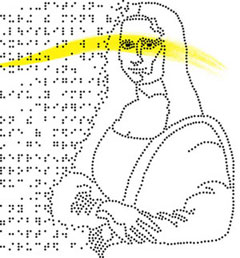
APH warmly invites artists who are blind or visually impaired, of all ages, to submit artwork for the 2017 APH InSights Art Competition. For over 25 years, our renowned international contest has delighted the senses, provoked discussion, and most importantly, allowed artists who happen to have vision loss the opportunity to share their creative imagination with the world.
Artists may enter original artwork created in any medium, including (but not limited to) painting, drawing, printmaking, fiber, metal, and wood. This year’s deadline for student artists from preschool through high school is March 24, 2017. The deadline for adult artists is March 31, 2017. Complete rules and entry forms will be posted on the APH website (archive.aph.org/museum/programs/insights/) by the end of January 2017, but now is the time to consider completed works of art, or finishing up existing projects for submission in the spring. We are always deeply inspired and grateful for the unique, artistic expression from each artwork, every year.
The excitement continues when a committee of jurors begins the daunting task of selecting 32 award winners and 80 works of art in several categories, from the hundreds of entries we receive. Artwork selected as “best in category” will be displayed at the InSights Art Exhibit during APH’s Annual Meeting, from October 12 to 14, 2017. Winning artists are also invited to celebrate their achievement at an awards banquet during Annual Meeting. Hundreds of Ex Officio Trustees, leaders in the field of blindness, teachers, and special guests from across the country attend this widely anticipated event. The banquet is a moving tribute to creative expression,and independence for all artists who have vision loss.
We look forward to your participation in our contest. For more information, please e-mail insights@aph.org, or call Rob Guillen, at 502-899-2242.
APH Welcomes New Ex Officio Trustee
- Paul Olson, the Department of Public Instruction in North Dakota.
Here’s a handy link to the full directory of Ex Officio Trustees.
APH on the Road
APH Presents at Kentucky Educational Development Corporation in Ashland, KY
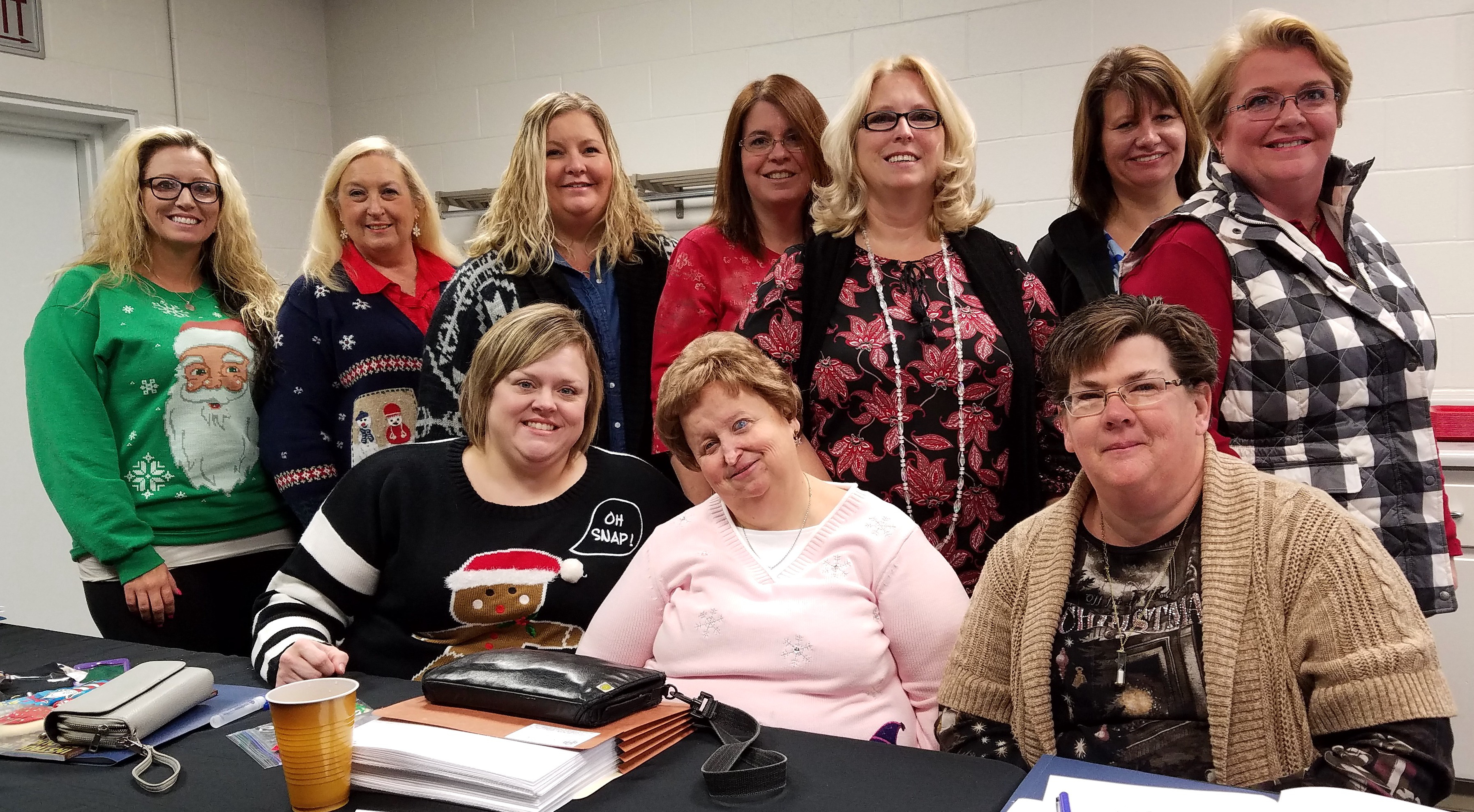
On December 13, Field Services Representative Kerry Isham presented to a very enthusiastic group of vision professionals at the Kentucky Educational Development Corporation in Ashland, KY. The day-long presentation covered the topics of literacy, tactile graphics, and math products from APH. Everyone also enjoyed some hands-on time with products, which included Setting the Stage for Tactile Understanding, Tactile Compass for Math and Art, EZeeCOUNT Abacus, and Tactile Graphic Line Slate.
Treasure from the Migel Library
Carroll, Thomas J. “Cecutiency Letter.” Letter to Ralph Peabody. 17 Oct. 1964. MS. Boston’s Catholic Guild for All the Blind, Boston, Mass.
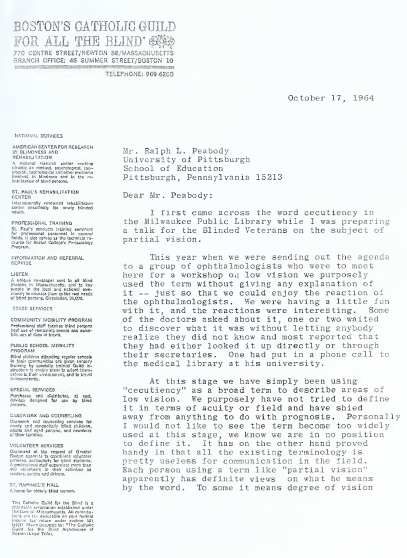
This playful letter was written by Father Thomas J. Carroll, who apparently was also known as the “Tycoon of Typhlology, Master of Mobility, Professor of Peripatology, and Champion of Cecutiency.” Father Carroll had decided to begin using the word “cecutiency” to describe areas of low vision in a broad sense. He offered little explanation of the fact when using the word, however, and enjoyed the reactions of the group he tried it out on. Father Carroll went on to discuss the lack of consistency in the terminology in the field of visual impairment, going as far as describing it as “useless.” This letter has been digitized for Internet Archive at https://archive.org/details/cecutiencyletter00thom
APH is working with the Internet Archive to digitize portions of the M.C. Migel Library. Search the phrase “full text” to find these items at http://migel.aph.org. The digitized texts are available in a variety of formats, including DAISY, Kindle, EPUB, PDF, etc.
The APH Barr Library supports research initiatives at APH, while the Migel Library is one of the largest collections of nonmedical information related to blindness in the world. Although the collections do not circulate, arrangements can be made to use the materials on-site. In addition, an ongoing digitization effort means APH will continue to make materials available through the online catalog at http://migel.aph.org.
Contact Library staff: library@aph.org, 800-223-1839, ext. 705
Social Media Spotlight
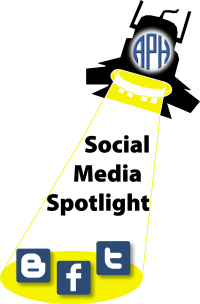
Have you checked out APH’s Facebook page recently? We post sale items on Mondays, new or recently released products on Tuesdays, our fun Quick Tips videos on Wednesdays, exciting artifacts from our Museum on Thursdays. We also post links to new posts to our Fred’s Head blog, Museum events, themed posts for various days (such as Louis Braille’s birthday!) and other interesting APH and blindness-related news for you to enjoy.
"Like" APH at Our Facebook Page!

We invite you to visit our Facebook page and "Like" us! You can find APH at these social media sites: Twitter, Google+, YouTube, Pinterest, and at our blog, Fred’s Head from APH.
APH offers a number of recreational books in braille (Quota funds can be used). Each of these titles was originally transcribed and produced by APH for the National Library Service which has graciously granted permission for this offering. As usual, these titles have been added to the APH Louis Database where you can find thousands of titles produced in accessible formats.
Note: all books are produced upon receipt of orders, therefore, please allow several weeks for delivery.
Hattie Ever After
by Kirby Larson: T-N1988-80 — $89.00
In 1919, seventeen-year-old Hattie leaves the Montana prairie and her sweetheart Charlie to become a female reporter in San Francisco. Grades 6-9. *(AR Quiz No. 53533, BL 4.6 Pts 8.0)
Robopocalypse: A Novel
by Daniel H. Wilson: T-N2143-40 — $174.00
In the near future, artificial intelligence leaps ahead of humans’ abilities and can no longer be contained. When a computer program escapes from the lab and initiates random attacks, most people remain unaware until it’s too late — robots have already taken over the world. Some Adult Content.
Alive, Alive, Oh! And Other Things That Matter
by Diana Athill: T-N2158-80 — $62.00
The author of Somewhere Towards the End continues, at ninety-seven years old, to write about aging. Topics include cherished memories of her grandmother’s garden, her experience of miscarrying a child in her forties, and her decision to move into a retirement home.
Demeter and Persephone
by Hugh Lupton and Daniel Morden: T-N2131-00 — $19.00
Persephone, beautiful young daughter of the harvest goddess Demeter, is kidnapped by Hades, the god of the underworld. Demeter is heartbroken, and even though the crops are dying, she cares for nothing but getting her daughter back.
Boys in the Boat: Nine Americans and Their Epic Quest for Gold at the 1936 Berlin Olympics
by Daniel James Brown: T-N2149-50 — $253.00
Tells the story of the University of Washington’s 1936 eight-oar crew and their epic quest for an Olympic gold medal, a team that transformed the sport and grabbed the attention of millions of Americans. It traces the story of the team that defeated elite rivals at Hitler’s 1936 Berlin Olympics, sharing the experiences of their enigmatic coach, a visionary boat builder, and a homeless teen rower.
*Accelerated Reader quiz number, book level, and point value. For more information on the Accelerated Reader program, see the January 2006 APH News or www.renlearn.com/ar/
APH Quick Tips—Happy Braille Literacy Month!

Happy New Year, and Happy Braille Literacy Month! Here at Quick Tips HQ, we want to make sure you begin 2017 on the right track, so we have collected our favorite braille-related Quick Tips for your viewing edification and pleasure:
- APH School and Office Products – APH has a ton of office and stationery products for your braille writing and large print needs. Examples from the video: the Spiral Pocket Notebook, the 6-Ring Pocket Size Notebook, and Braille Pocket Folders.
- The Impressor – Make your business cards accessible with this handy embosser!
- Rare Louis Braille Book – See the first book describing and explaining braille code at the APH Museum!
- Building on Patterns – Kristie Smith, a TVI from Texas tells us why she loves Building on Patterns!
How’s that for starting off 2017 with a big, braille bang?
As always, if you have any feedback or suggestions – or if you’d like to submit your own Quick Tip – email Kerry at kisham@aph.org!

APH Travel Calendar
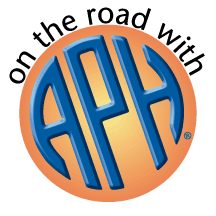
NIP Events
January 12-13, 2017
NIP: Building Literacy with Building on Patterns
Baton Rouge, LA
Exhibits/Presentations
January 19-21, 2017
ATIA 2017
Orlando, FL
March 8, 2017
Focus on Vision Impairment
Norwood, MA
March 20-23, 2017
KAER 2017
Lexington, KY
March 29-April 1, 2017
American Occupational Therapy Association Annual Conference
Philadelphia, PA
Conferences
February 15-17, 2017
Illinois AER Conference
Naperville, IL
February 21-24, 2017
NASP Annual Convention
San Antonio, TX
February 27-March 4, 2017
CSUN 2017
San Diego, CA
March 1-4, 2017
SREE (Society for Research on Educational Effectiveness)
Washington, DC
March 8-11, 2017
ATP Innovations in Testing 2017
Scottsdale, AZ
March 9-12, 2017
CTEBVI 58th Annual Conference
San Francisco, CA
March 14-18, 2017
SHAPE America 2017 Convention
Boston, MA
March 29-April 1, 2017
International Brain Injury Association World Congress
New Orleans, LA
Subscribe to the APH News!
Get convenient email reminders every month when a new issue of the APH News is released.
It’s Easy!
- Prepare an email to aphinfo-request@iglou.com.
- Leave the subject blank.
- Type the word ‘subscribe’ (without any quote marks) in the body of the message.
- Send it!
APH News Credits
President:
Dr. Craig Meador
cmeador@aph.org
Editor:
Dorinda Rife, Vice President, Educational Services and Product Development
drife@aph.org
Designer:
Malcolm Turner, APH Website Coordinator
webmaster@aph.org
Thanks to the following APH staff:
- Cindy Amback, Support Specialist, Field Services
- Janie Blome, Director, Field Services
- Scott Blome, Director, Communications
- Paul Ferrara, Social Media Coordinator, Communications
- Justin Gardner, Special Collections Librarian, Resource Services
- Rob Guillen, Special Programs Coordinator, Public Relations
- Rosanne Hoffmann, STEM Project Leader, Research
- Mike Hudson, Director, APH Museum
- Kerry Isham, Field Services Representative
- Stephanie Lancaster, Graphic Designer, Communications
- Drew Lueken, Support Specialist, Communications
- Artina Paris-Jones, Assistant, Field Services
- Larry Skutchan, Director, Technology Product Research
- Denise Snow, Technical Communications Specialist, Technology Product Research
Recent and past issues of APH News:
The APH News is a monthly publication from the American Printing House for the Blind:
1839 Frankfort Avenue
Louisville, KY 40206
800/223-1839
Please share this web link or any items that appear in this publication with anyone who might benefit.
Thank you.


